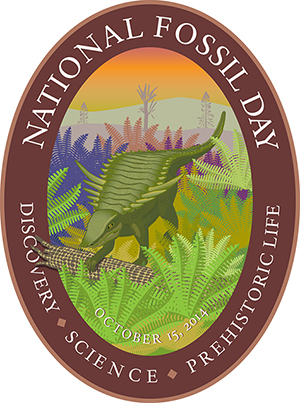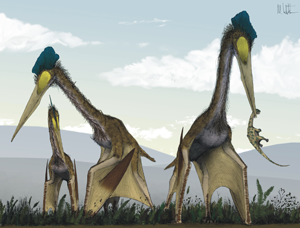Mesozoic Ecosystems

The 2014 National Fossil Day artwork features an ancient reptile, known as an aetosaur, surrounded by a variety of Late Triassic plants. The scene is an idealized representation of a Mesozoic Era ecosystem which is the theme for the 2014 National Fossil Day monthly features.
The Mesozoic, the era of "Middle Life", is divided into three geologic time periods—the Triassic, Jurassic and Cretaceous. The beginning and end of the Mesozoic are marked by worldwide mass extinction events. The Mesozoic Era spans from 252 million to 66 million years before present.
The Mesozoic is also commonly referred to as the "Age of Reptiles" because of the great diversity of reptiles which evolved and successfully inhabited terrestrial and marine environments worldwide. In addition to all of the different groups of dinosaurs, many non-dinosaurian reptiles shared the land and inhabited the seas during the Mesozoic.

Image from Witton and Naish (2008)
These diverse non-dinosaurian reptiles are sometimes mistakenly called "dinosaurs" and include the mosasaurs, plesiosaurs, ichthyosaurs, pterosaurs, rauisuchians, phytosaurs, synapsids ("mammal-like reptiles") and the birds.
The evolution of plants changed the landscape of the Mesozoic ecosystems. The Triassic was dominated by ferns, cycads, and ginkgophytes. Modern gymnosperms and conifers appeared during the Jurassic. The first appearance and rapid diversification of angiosperms (flowering plants) occurred during the Cretaceous. The animals and plants of the Mesozoic provide a rich and interesting story for life during the "Age of Reptiles".
Go See Them!
Many National Fossil Day partner fossil sites and museums are excellent places to learn about Mesozoic Era fossils and ecosystems. Below are just a few National Fossil Day partners which preserve a portion of the Mesozoic story.
Garden Park Fossil Area is an internationally known paleontological site that was one of the primary areas responsible for generating worldwide interest in dinosaurs during the late 1800's. Fifteen species of dinosaurs, nine of which were new, were recovered from here at that time. Fish, crocodile, turtle, and mammal fossils have also been recovered, making this site one of the oldest and richest fossil sites in the United States. The Garden Park Fossil Area is managed by the Bureau of Land Management, Royal Gorge Field Office located in Cañon City, Colorado. The Garden Park Fossil area is also a National Natural Landmark.
Dinosaur State Park, Connecticut, is one of the largest dinosaur track sites in North America. The park preserves and exhibits Jurassic fossil tracks that were made 200 million years ago. The Museum at Dinosaur State Park presents a bird's-eye view of the preserved Mesozoic floodplain covered with tracks, dioramas of Triassic and Jurassic environments, collections of fossils, and interactive exhibits. This park is a premier paleontological site in the northeastern United States. The dinosaur trackway portion is a National Natural Landmark.
Berlin-Ichthyosaur State Park, Nevada , was established in 1957 to protect and display North America's most abundant concentration and largest ichthyosaur (marine reptile) fossils known at the time. The park is a National Natural Landmark and provides visitors a window into an Mesozoic marine environment with complete skeletons of ichthyosaurs.
Bug Creek Fossil Site on the Charles M. Russell National Wildlife Refuge, Montana, has been designated as a National Natural Landmark because of the abundance of Cretaceous mammals preserved there. The isolated bones, jaws or jaw fragments, and teeth indicate that these mammals must have been tiny, mouse-sized or smaller. More than 26,000 mammal teeth, 1,000 mammal jaw fragments and hundreds of isolated mammal bones have been excavated, representing 20 different species of multituberculates, marsupials and true mammals.
Big Bend National Park, Texas, preserves an important assemblage of Late Cretaceous vertebrates and plants. The Big Bend fauna is dominated by “Texas-Sized” reptiles including the largest known flying animal Quetzalcoatlus, the massive crocodile-like predator Deinosuchus, large turtles and a variety of dinosaurs. Fossil marine reptiles, early mammals and petrified logs contribute to the Late Cretaceous ecosystem preserved at Big Bend National Park.
Learn more about National Fossil Day and the NFD Logos and Artwork on the official National Fossil Day website.
Part of a series of articles titled National Fossil Day Logo and Artwork – Prehistoric Life Illustrated.
Last updated: September 8, 2020
